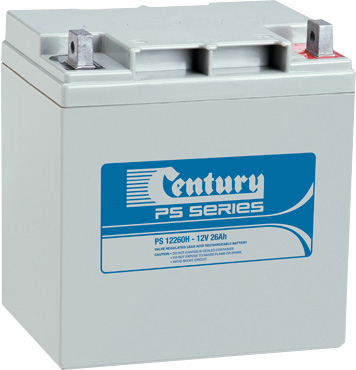Batteries for Off-grid Solar Power Systems

A sealed lead acid (SLA) battery
Batteries
Batteries are vital in off-grid solar PV systems. They provide a means to capture the sun's energy for later use, especially at a time when the sun is not shining. Batteries also act as a reservoir, and are especially useful when a high-energy appliance needs to be briefly used, and the appliance's power draw exceeds the power output of the solar panels.
There are many types of batteries, however, for a fixed or semi permanent installation, the type used is the lead acid battery.
Lead acid betteries come in several types: wet cell (flooded) and sealed. Within these two mian types, there are deep cycle, AGM and VRLA (or a combination of them).
Why not just use car batteries?
As cheap and plentiful as they may seem, car (automotive) batteries are unsuitable for use in PV systems. Car batteries are designed primarily for engine starting. Their plates in each cell are made from thin sheets of lead to maximise the surface area, allowing it to deliver the high currents required for starting engines. These batteries excel for 'burst' use. Any other slow discharge usage is bad for the batteries, because when the car battery is discharged, their thin plates are much more susceptible to sulphation. The only reason why they last in cars is because as soon as a car is started, the alternator immediately begins to charge the battery. In solar PV systems, a car battery discharged from long-running night lighting will stay discharged until sunrise. In that time, sulphation starts to occur in the battery.
Car battery sulphation is even more of a problem during times of insufficient sunlight. If there are several cloudy days, there will not be enough energy to fully recharge the batteries. If the user is not careful and continues to use night lighting and other loads, the chronically undercharged car batteries will deteriorate badly, often irreversibly.
Deep cycle batteries have thick plates which are far more resistant to sulphation. They can tolerate being in a discharged state better than automotive batteries. High quality deep cycle batteries can tolerate being in a discharged state (no more than 50%) for up to a week with minimal ill effects.
What about used (secondhand) batteries?
There are many people selling used batteries on the market, from the average Joe (such as a golf buggy) right through to the corporate users (such as in large telecommunications power backup systems). The price may be tempting, but you need to be exactly sure you are getting what you pay for. You will be reliant on the previous owner to provide you with the history of the battery, and whether it has been cared for or not. You simply will have to take the seller's word that the battery has never been abused...
Building a battery bank with cheap secondhand batteries is false economy. Often, a single underperforming battery can degrade the performance of an entire string of batteries, leading to a highly inefficient solar power system.
Old batteries will have lost their original efficiency. A new battery may have 90% efficiency, which means for every watthour you consume, you will need to recharge it with 1.1 watthours to replace the energy you used. But an old battery may only have 50% efficiency, meaning you need to put back 2 watthours into the battery for every watthour you consume! The remedy for this is to install more solar panels - but the extra cost will nullify the benefits of cheaper batteries.
In an off-grid solar power system, batteries are a critical component. If your budget is limited, you will be better off spending the money on better batteries and less on solar panels. The batteries are often an afterthought, but yet are at the very heart of the off-grid system.
If you are thinking about skimping on batteries, think again! Skimp elsewhere - such as buying smaller or less solar panels.
Battery Bank
A battery bank is simply a collection of two or more batteries connected together to operate as if it were a single larger battery.
Connecting multiple smaller batteries also results in a higher apparent capacity due to the Peukerts Effect. Because each individual battery is experiencing a lower discharge rate, they can deliver more power than a single battery with equal capacity to the bank, for a given current draw.
There are 12v, 24v and 48v systems. In systems with voltages higher than 12v, the batteries are wired in series (or series-parallel) to achieve the higher voltage.
